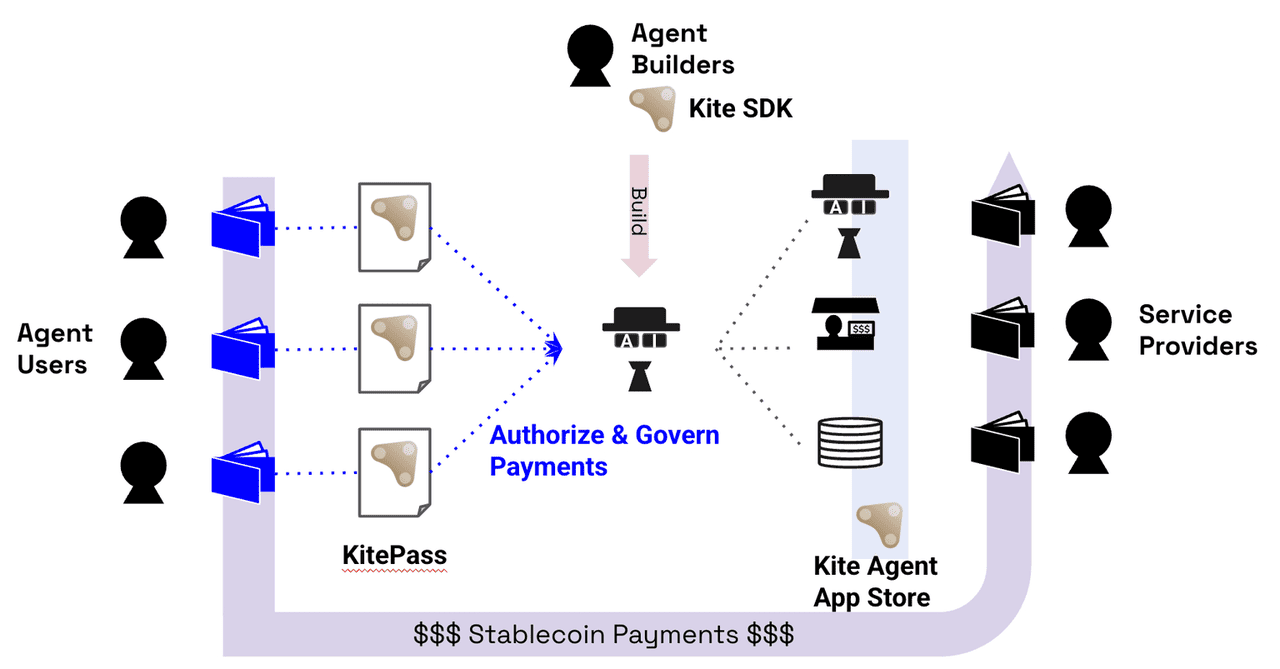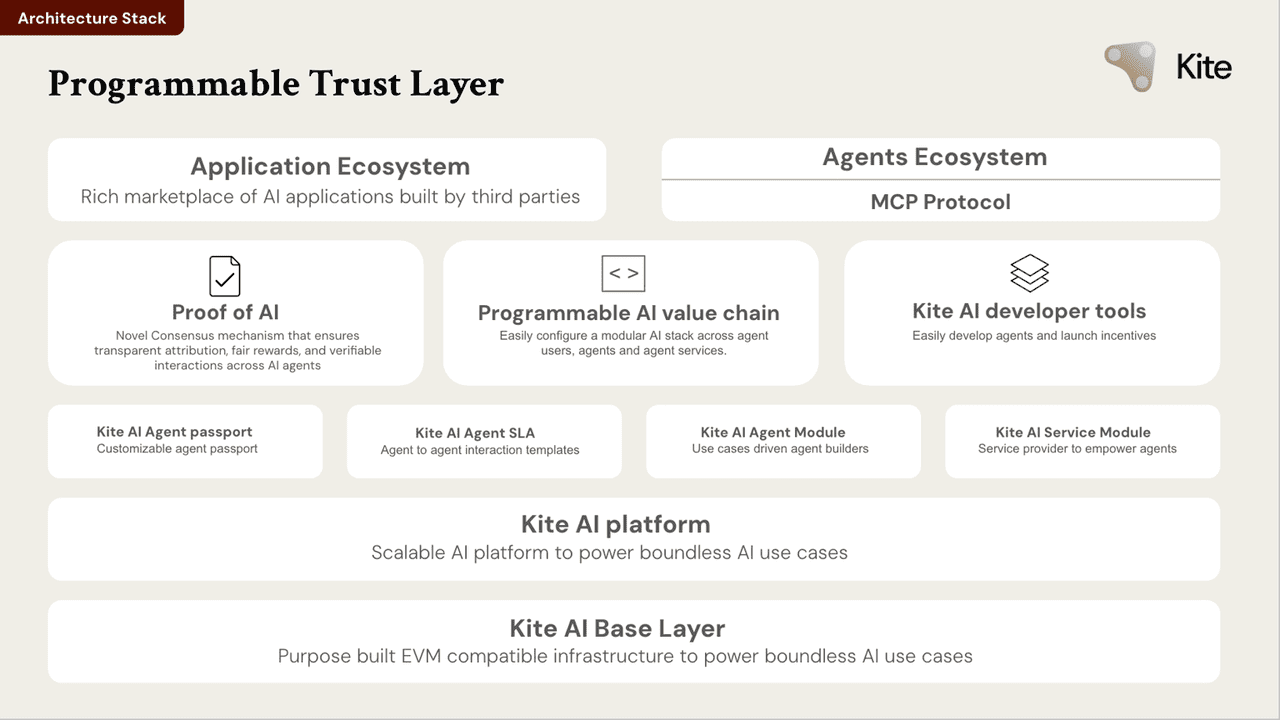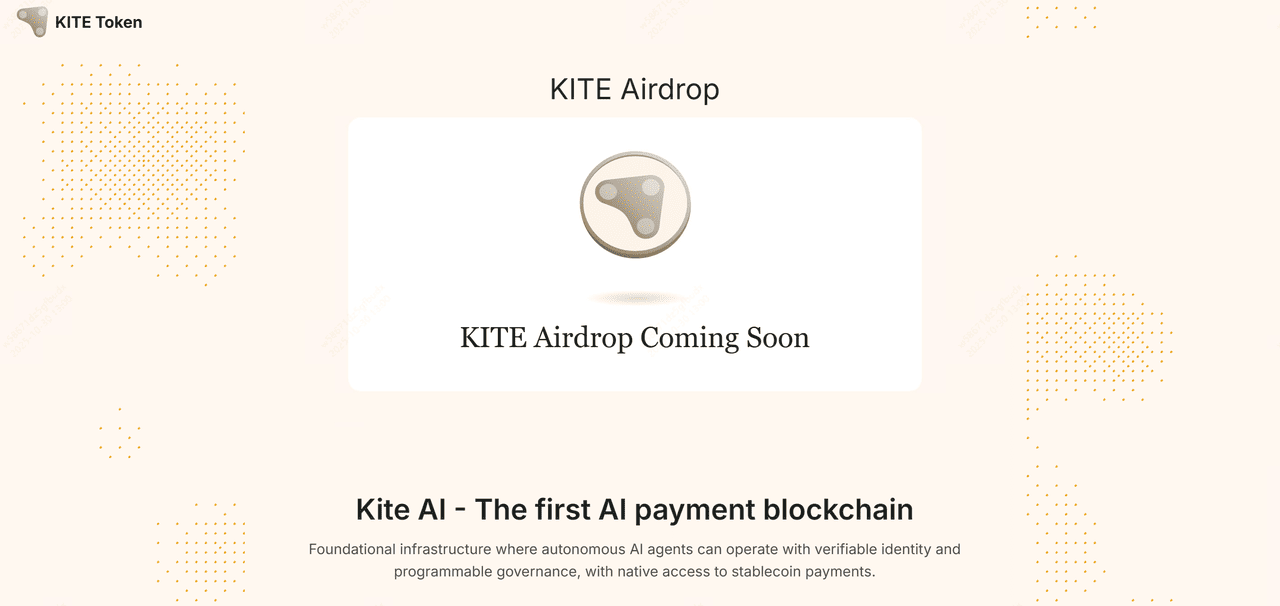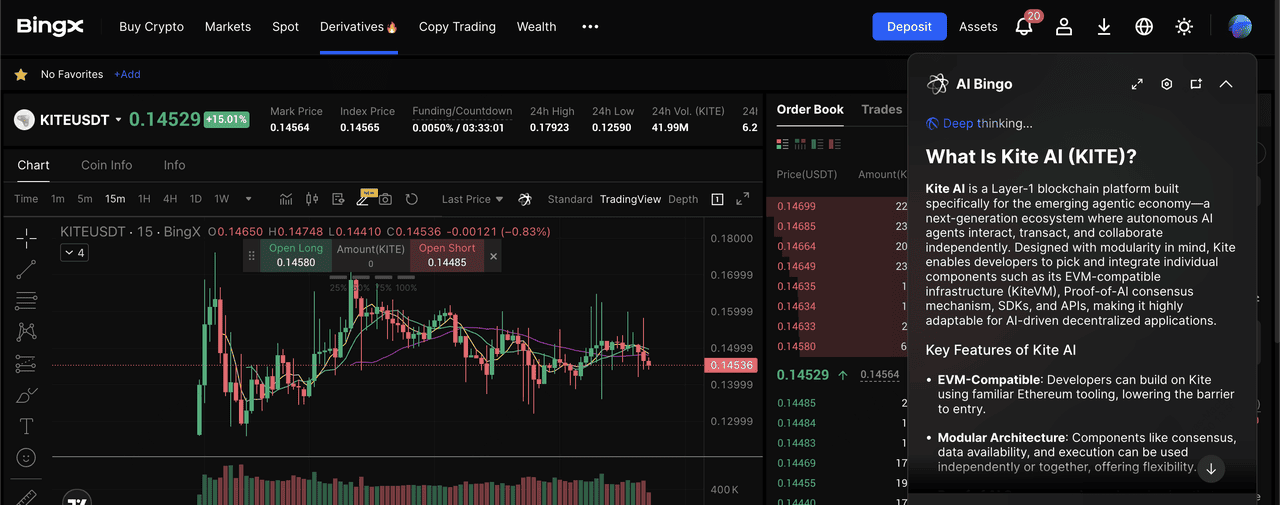Kite AI is a specialized Layer-1 blockchain built for autonomous agent payments, processing micro-transactions with around 1 second block times and near-zero gas. Instead of people clicking “buy,” Kite lets
AI agents shop, book flights, order groceries, trade crypto, or settle invoices on their own. It is one of the first chains to natively integrate Coinbase’s
x402 intelligent payment standard, enabling agents to pay, retry, and settle directly from a wallet, no logins, API keys, or billing accounts required.
On October 30, 2025, Kite AI launched its Airdrop Eligibility Checker, allowing users to verify whether they qualify to claim $KITE, ahead of the official airdrop and token listing scheduled for November 3, 2025. If you used the Kite AI testnet with email, GitHub, or socials, you must bind an EOA (EVM wallet) to stay eligible before the November 2 deadline.
This guide explains what Kite AI is, who qualifies for the KITE token airdrop, how to use the airdrop eligibility checker, and how to claim $KITE tokens, including details from official sources.
What Is Kite AI (KITE) Layer-1 Blockchain for AI Agents?
Kite AI is an EVM-compatible Layer-1 blockchain built for AI agents, programs that can browse, buy, book, and pay on your behalf. It gives every agent (or model, dataset, or service) a verifiable on-chain identity, fine-grained permissions/governance, and machine-native payments that plug into Coinbase’s x402 standard so agents can pay-per-request and retry in one flow. In plain English: Kite is payments + identity + rules for AI agents, all on a fast L1.
Kite AI has raised $33 million to build the payment and trust infrastructure for autonomous agents, including an $18 million Series A on September 2, 2025 led by PayPal Ventures and General Catalyst, with Coinbase Ventures joining on October 27, 2025 to expand adoption of x402 machine payments. These investors describe Kite as the next “payment substrate” for agentic commerce, just as e-commerce, mobile apps, and real-time payments required new financial rails, autonomous AI will need its own verified identity and settlement layer.
On the network side, Kite’s testnet has evolved from Aero to Ozone, recording large-scale agent interactions, bridge transactions, multisig tests, and ongoing quests/SBTs, signaling sustained community participation ahead of mainnet.
What Problems Does Kite AI Solve for AI Agents?
Roles in the Kite AI ecosystem | Source: Kite AI docs
• Agents need trust: Kite’s identity layer helps prove “who” an agent is, e.g., a real merchant bot vs. a spoof, reducing fraud and spam.
• Agents need to pay: Native x402 support enables instant, low-fee micro-payments without clunky API keys or billing accounts.
• Agents need credit: Kite’s Proof of Attributed Intelligence (PoAI) records who contributed what (data, model, or action) and rewards the right party, useful for transparent bounties, rev-share, or “pay per useful output.”
How Does Kite AI Network Work?
An overview of Kite AI's architecture | Source: Kite AI docs
Kite AI runs on a new consensus model called Proof of Attributed Intelligence (PoAI). Instead of rewarding miners for raw computing power, PoAI rewards agents for useful AI work, such as completing tasks, running models, improving data, or interacting with other agents. Every action is logged on-chain with attribution, so the network can verify who contributed value and automatically route rewards to the correct wallet. It works like “proof of work,” but the work is real intelligence and productivity, not just hashing.
To support millions of tiny automated payments, Kite is engineered for speed and low cost. The network targets ~1-second block times and near-zero gas, often below $0.000001, making machine-to-machine transactions cheap enough for autonomous commerce.
Developers can deploy Solidity contracts because Kite is EVM-compatible, and it offers SDKs, APIs, an explorer, validator dashboards, and bridging support for Ethereum and other EVM chains. With over 1.7B agent interactions, 17.8M+ agent passports, and 100+ agent modules, Kite provides the infrastructure AI agents need to operate safely, verify identity, and transact without human involvement.
Key Features of Kite AI
• Near-zero gas fees (<$0.000001)
• 1-second average block time
• More than 1.7B agent interactions recorded
• 17.8M+ agent passports issued
• 100+ modules for autonomous agent development
What Is the $KITE Token Used For?
The KITE token powers the entire agent economy:
1. Gas and Fees: KITE is used to pay for on-chain transactions and computation whenever agents interact or make payments.
2. Staking: Users can stake KITE to help secure the network and earn block rewards over time.
3. Validator Delegation: If you don’t run a validator, you can delegate your KITE to someone who does and share in their rewards.
4. Governance: Holding KITE gives you voting power on protocol upgrades, treasury spending, and future ecosystem decisions.
5. DeFi and Liquidity: KITE acts as a base trading and liquidity asset across decentralized exchanges, lending pools, and other dApps.
Kite AI Tokenomics
The total supply is capped at 10 billion KITE, with structured allocations that reward early contributors, secure the network, and fund long-term ecosystem growth.
KITE Token Allocation
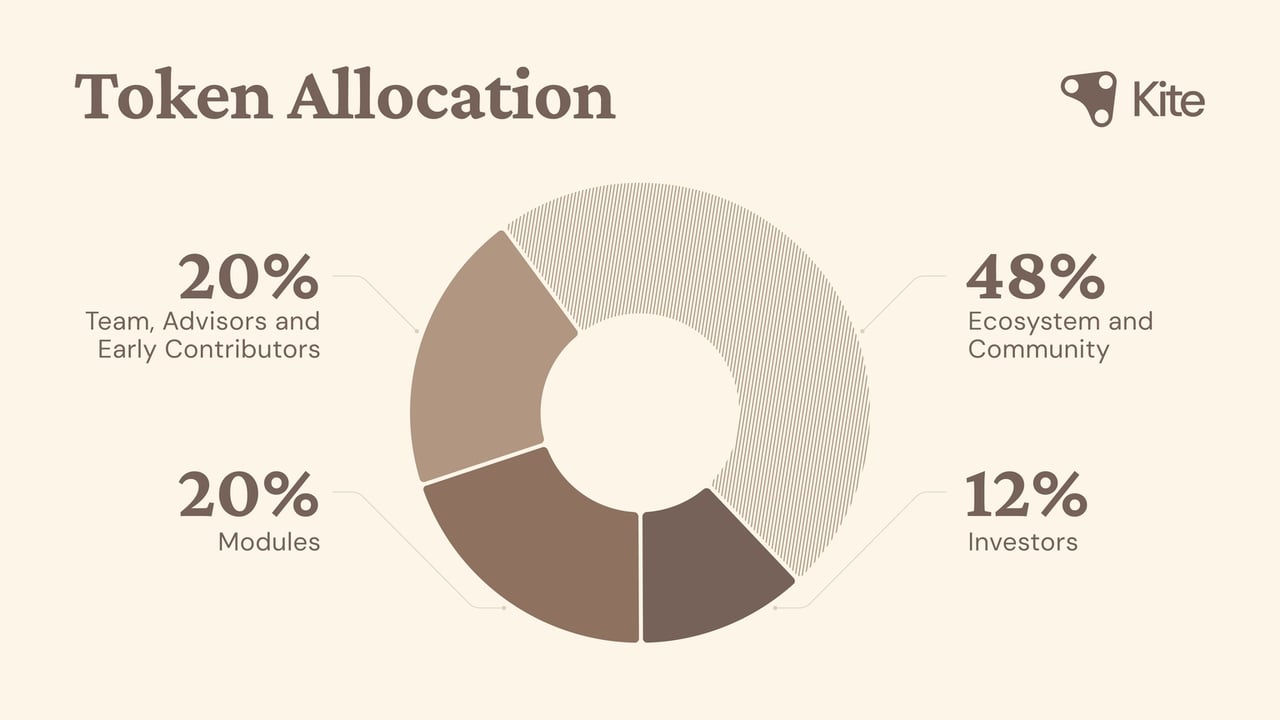
KITE token distribution | Source: Kite AI docs
• Ecosystem & Community – 48%
- Accelerates user adoption, developer engagement, and ecosystem liquidity
- Funds community airdrops, liquidity programs, and growth incentives
- Rewards meaningful contributions that help Kite transition from launch to broad utility
• Modules – 20%
- Incentivizes development of high-quality AI services and infrastructure
- Supports developer grants, performance-based rewards, and service expansion
- Used to build out tools and services that improve network intelligence and accessibility
• Team, Advisors and Early Contributors – 20%
- Multi-year vesting to align long-term incentives with network stability
- Rewards early builders, developers, and strategic advisors
- Ensures accountability and sustained ecosystem growth
• Investors – 12%
- Distributed under structured vesting schedules
- Ensures early financial supporters stay committed to long-term network growth
- Supports strategic partnerships and ecosystem expansion
What Is the Kite AI Airdrop and Who Is Eligible?
Source: Kite AI
The Kite AI airdrop is a reward program designed to distribute $KITE tokens to real contributors who helped test and grow the network. Testnet users, content creators, builders, and community members can receive token allocations based on their recorded activity, such as bridging, swapping, staking, creating agent content, or completing on-chain quests.
Who Is Eligible for $KITE Airdrop?
You may qualify for the $KITE airdrop starting on November 3, 2025, if you fall into one or more of these groups:
1. Testnet Users: Anyone who interacted with Bridge, Swap, Multisig, the Faucet, Agent Store, or Tesseract DEX; every on-chain action increases XP and allocation score.
2. Social Contributors: Users who followed @GoKiteAI, joined Telegram or Discord, and linked socials to their dashboard.
3. Wind Runner Program: Creators who posted high-quality original content on X and earned Gold, Silver, or Bronze SBTs; quality matters more than volume.
4. Layer3 and Campaign Participants: Users who completed official quests proving on-chain participation.
5. Community Roles: Verified contributors with roles like Wind Runner, Testnet Pioneer, or Early Agent Builder.
Note: Meeting criteria does not guarantee tokens. Final rewards depend on activity quality, wallet binding, and anti-sybil checks.
Kite AI Launches Airdrop Eligibility Checker on October 30
On October 30, 2025, Kite AI launched its Airdrop Eligibility Checker, allowing users to confirm whether they qualify and how many rewards they may receive ahead of the official airdrop and token listing on November 3, 2025. Anyone who previously used the testnet through email, GitHub, or social accounts must now bind an
EVM wallet (EOA) to remain eligible.
The deadline to bind your wallet is November 2, 2025, and it applies to all XP, badges, referrals, quests, and token distributions. This requirement helps block bot activity and ensures that rewards only go to real testnet participants. If you previously used the Aero testnet, you’ll still need to verify activity inside Ozone, quizzes, modules, and badges must be minted again, as not all Aero progress maps 1:1.
How to Use the Kite AI Eligibility Checker: Step-by-Step Guide
Binding your EVM wallet ensures all your XP, badges, and proofs are tied to a real Web3 address instead of an email or social login, which is required for token distribution.
1. Visit the Dashboard – Go to https://testnet.gokite.ai. Remember to always verify official links to
avoid phishing.
2. Log In – Sign in with the same method you used on the testnet (email, GitHub, Google, or social).
3. Open Your Profile – Click Profile in the top-left corner.
4. Bind Your Wallet (EOA) – Select Bind EOA → Change → Add Wallet, then connect
MetaMask or any EVM-compatible wallet.
5. Connect Social Accounts – Make sure Telegram, X, and Discord are linked.
6. Check Eligibility – The dashboard will show whether you qualify and your estimated rewards.
Note: While eligibility checks are live, Kite has not officially announced the TGE or confirmed a token release date. All participation should be treated as testnet activity unless an official announcement is made.
How to Claim KITE Tokens After TGE
Once the Token Generation Event goes live, eligible users will be able to claim their KITE token airdrop directly through the official claim portal. Just follow these quick steps:
1. Visit the Official Claim Portal – Only use links shared on Kite AI’s website or verified social channels.
2. Connect Your Wallet – Use the same EVM wallet you bound during the eligibility check.
3. Check Eligibility – Click Check Eligibility to see if your wallet qualifies for a claim.
4. Claim Tokens – If you’re eligible, click Claim Tokens and proceed.
5. Confirm the Transaction – Approve the transaction in your wallet to receive the tokens.
6. View Your Balance – Add the KITE token contract address to your wallet so the balance shows up.
Claims may happen on the Kite mainnet or Ethereum, depending on settlement rules, so keep a small amount of gas token like
ETH ready to process the claim.
How to Trade Kite AI (KITE) on BingX Futures
KITE/USDT perpetual contract on the futures market powered by BingX AI
You can trade Kite AI (KITE) on
BingX Futures if you prefer leveraged exposure or want to hedge short-term price swings ahead of the official $KITE TGE. To get started, open a Futures account on BingX, deposit
USDT, and search for the
KITE/USDT Perpetual contract.
Choose between Long (buy) if you think price will rise, or Short (sell) if you expect a decline, then select your leverage and order type (Market or Limit).
Always set a
stop-loss and use isolated margin if you’re a beginner, since futures carry higher risk. You can also enable
BingX AI risk controls or copy experienced traders to manage volatility more safely.
What Role Does the Kite Foundation Play in $KITE Airdrop and Growth?
Kite created the Kite Foundation to support long-term growth of the agent economy, not just short-term testnet activity. The foundation funds builders, partners, researchers, developers, and creators who are bringing autonomous payments and AI agents into real products. Its mission focuses on three pillars: driving adoption of autonomous infrastructure, expanding the global Kite community, and empowering innovation through grants, education, and technical support.
For airdrop participants, this matters because it shows that Kite is building a sustainable ecosystem rather than a one-time distribution. As more developers integrate x402 payments and launch agent-powered applications, demand for tools, liquidity, and the KITE token can grow naturally over time. In simple terms, the Kite Foundation helps ensure the network keeps improving after the airdrop, making the ecosystem stronger for users, builders, and token holders.
Final Thoughts
The Kite AI airdrop rewards real builders of the agentic economy, and not passive airdrop hunters. If you used the testnet, interacted with agents, created content, or contributed on-chain, binding your EVM wallet before November 2 ensures you do not lose eligibility.
Kite’s momentum is backed by world-class investors, a working testnet, and live agent interactions at scale. Its integration of Coinbase x402, Proof of AI consensus, and machine-native payments makes it one of the fastest-growing projects at the intersection of AI and crypto.
However, like all crypto tokens, $KITE remains a volatile asset. Allocation amounts may change, and receiving eligibility does not guarantee long-term returns. If you choose to trade KITE on BingX, start small, use official links, and only invest what you can afford to lose.
Related Reading

